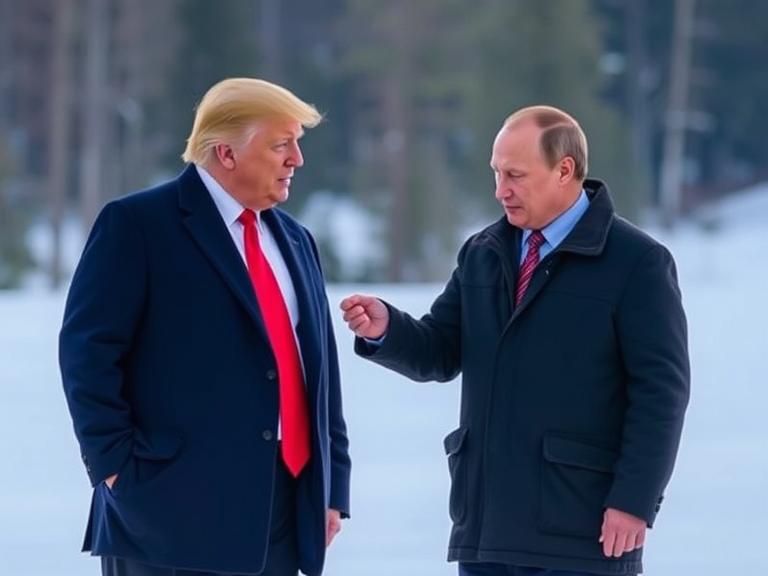
Introduction to the Alaska Summit
The Trump-Putin meeting held in Anchorage, Alaska, represents a pivotal moment in the realm of international diplomacy. The significance of this summit lies not only in the personal interactions between these two prominent leaders but also in the broader geopolitical context that shapes their nations’ relationships. Positioned as a crucial opportunity for dialogue, the summit aimed to address pressing global issues ranging from nuclear security to trade tensions.
Amidst ongoing concerns regarding military expansion and cybersecurity threats, the summit offered President Trump a platform to engage directly with President Putin. With relations between the United States and Russia historically strained, expectations were high for tangible outcomes that could potentially ease diplomatic tensions. The backdrop of this meeting was characterized by fluctuating alliances and rivalry, making the need for candid negotiations all the more critical.
The discussions anticipated during the Alaska summit would likely touch upon key points such as arms control, regional conflicts, and economic sanctions. Both leaders entered the meeting with distinct agendas and national interests, representing nations with divergent viewpoints on numerous global events. Trump, focusing on America’s economic prosperity and national security, hoped to counter any perceived aggressions while fostering a cooperative atmosphere. Conversely, Putin aimed to assert Russia’s influence and advocate for its strategic interests in the face of international scrutiny.
Understanding the nuances of the Trump-Putin meeting necessitates an appreciation of prior interactions and historical context. The Alaska summit serves as a reflection of evolving diplomatic strategies and the intricate power dynamics at play between the U.S. and Russia. As both leaders prepared for their discussions, the world watched closely, paying attention to how their meeting could reshape future bilateral engagements and address lingering global tensions.
Context of U.S.-Russia Relations
The relationship between the United States and Russia has undergone significant transformations since the end of the Cold War, characterized by a cycle of cooperation and confrontation. During the 1990s, there was a period of optimism as both nations sought to redefine their diplomatic ties, highlighted by arms reduction agreements and collaborative efforts in various global issues. However, this period of thawing quickly deteriorated as geopolitical tensions resurfaced, particularly in the early 2000s.
A pivotal moment came in 2008 when Russia’s military intervention in Georgia raised alarms in Washington, signaling a more assertive Kremlin under Vladimir Putin. The subsequent accession of Putin to the presidency further complicated relations, as the U.S. navigated issues like NATO expansion and the ongoing conflict in Ukraine. These events sowed distrust, leading to economic sanctions imposed on Russia by the U.S. and its allies. The role of misinformation and cyber warfare exacerbated these tensions, particularly during the 2016 U.S. presidential election, where Russian interference was heavily publicized.
Under the administrations of both Donald Trump and Vladimir Putin, the diplomatic landscape became increasingly polarized. Trump’s overtures towards strengthening U.S.-Russia ties created controversy domestically, with critics expressing concern over potential policy shifts that favored the Kremlin. The Trump-Putin summit in 2018 was a focal point that encapsulated their complex relationship, as both leaders attempted to break the cycle of mistrust that had developed over the years.
Despite the challenges of U.S.-Russia relations, areas of potential collaboration remain. Issues such as nuclear disarmament, counter-terrorism, and climate change require cooperative efforts from both nations. The dynamics of their relationship continue to evolve, influenced by regional conflicts, economic sanctions, and domestic political considerations in both countries. As we examine the context leading to the Alaska summit, it is essential to recognize the historical underpinnings that have shaped this crucial bilateral relationship.
Key Agenda Items Discussed
The Trump-Putin meeting in Alaska emerged as a significant diplomatic endeavor, presenting a platform for both leaders to address pressing global issues. One of the paramount agenda items discussed was security concerns, particularly in relation to nuclear proliferation and cyber threats. President Trump emphasized the necessity for mutual cooperation in combating terrorism and ensuring regional stability. On the other hand, President Putin highlighted the importance of dialogue in addressing these security threats, positioning Russia as an essential partner in global security initiatives. This focus on security underlined the need for a coordinated effort between the United States and Russia in tackling mutual challenges.
Another crucial topic addressed during the summit was military cooperation. Both Trump and Putin acknowledged the importance of maintaining open lines of communication between their respective military forces to prevent conflicts. By discussing avenues for potential joint military exercises and information sharing, the leaders aimed to de-escalate tensions that have historically characterized the U.S.-Russia relationship. This agenda item was viewed as a pivotal step towards fostering trust and reducing the risk of misunderstandings in military affairs.
Trade agreements also featured prominently in the discussions. President Trump advocated for the enhancement of trade relations, arguing that economic cooperation could serve as a stabilizing factor in U.S.-Russia ties. Conversely, Putin pointed out the adverse impact of sanctions on trade, suggesting that easing these restrictions could benefit both nations economically. Furthermore, the issue of the Ukrainian conflict was explored, with Trump urging a peaceful resolution and Putin reiterating Russia’s position while offering to explore diplomatic avenues for conflict resolution. These discussions reflected a complex interplay of interests that could potentially shape future international relations.
Overall, the meeting served as a critical juncture for both Trump and Putin to openly discuss vital issues, laying the groundwork for potential future engagements. As these agenda items were addressed, they offered insights into the leaders’ positions and the evolving nature of diplomatic relations between the two nations.
Media Reactions and Coverage
The recent summit between Trump and Putin in Alaska has sparked significant media coverage, with various outlets providing distinctly different perspectives. Major networks such as CNN, MSNBC, and Fox News have each carved out their narrative regarding the meeting, showcasing a diverse array of analyses and public reactions to the diplomatic engagement. Observers noted that CNN took a critical approach, highlighting concerns over national security and the implications of Trump’s conciliatory tone toward Putin. Analysts on this platform emphasized the potential risks involved in the discussions, especially concerning cybersecurity threats and Russia’s influence on global affairs.
Conversely, MSNBC adopted a nuanced perspective by featuring expert opinion pieces that discussed the complexities of U.S.-Russia relations. Their coverage included interviews with former diplomats and strategists who offered insights into the overarching themes of the summit. The consensus among these analysts suggested that while the meeting was critical in keeping lines of communication open, it came fraught with mixed messages that might have long-term implications for NATO and global stability.
Fox News, known for its more favorable reports on Trump, framed the summit as a diplomatic success. Their coverage often spotlighted the positive reception from supporters who appreciated Trump’s willingness to engage with Putin. This outlet emphasized the need for dialogue rather than confrontation, positioning the meeting within the larger narrative of promoting peace and stability in the Arctic region. The potential for collaborative efforts concerning issues such as climate change and security in Alaska was presented as a highlight of the negotiations.
Public reaction to the summit has been varied, with some viewers expressing skepticism about the true intentions behind Trump and Putin’s cordial interactions. Social media platforms became a battleground for opinions, with mixed reactions reflecting the polarized views regarding the leaders’ ongoing relationship. Overall, media narratives surrounding the Trump-Putin meeting in Alaska frame a complex picture of contemporary diplomatic relations, suggesting that while dialogue is essential, genuine progress requires more than just ceremonial engagements.
Public Perception and Domestic Responses
The Trump-Putin meeting, particularly the highly publicized summit in Alaska, catalyzed a diverse range of public opinions and political responses within the United States. This diplomatic interaction drew polarized reactions across the political spectrum. Supporters of President Trump viewed the meeting as a significant opportunity to re-establish communication with Russia, emphasizing the importance of diplomacy in international relations. They argued that engaging with Vladimir Putin was a pragmatic approach in addressing pressing global issues.
In stark contrast, critics from the Democratic Party and even some factions within the Republican Party expressed concerns regarding the potential implications of the meeting. They highlighted Trump’s previous ambiguous statements regarding Russia and questioned the wisdom of granting legitimacy to Putin on such a significant platform. High-profile figures, such as Marco Rubio, articulated their apprehensions regarding Trump’s handling of foreign policy, warning that it could undermine U.S. strategic interests and empower adversaries.
Moreover, the advent of social media has played a crucial role in shaping public perception regarding the Trump-Putin interactions. Following the Alaska summit, social platforms became hotbeds for discussion, characterized by a mix of support, criticism, memes, and disinformation. Such dynamics have further polarized public sentiment, amplifying both approval and dissenting voices. The rapid dissemination of opinions on Twitter, Facebook, and other platforms contributed to a narrative that sometimes distorted the factual basis of the meeting’s outcomes.
The overall impact on Trump’s standing within the country has also been noteworthy. While some constituents appreciated his efforts to engage with Putin, others remained mistrustful, concerned about the implications for national security. The mixed responses from various political leaders and the public have illustrated the intricate web of perceptions surrounding U.S.-Russia relations. Evaluating such complex dynamics is essential to understanding the broader implications of the Trump-Putin meeting and its aftermath.
Analysis of Diplomatic Outcomes
The Trump-Putin meeting in Alaska marked a significant moment in the ongoing dialogue between the United States and Russia, laying the groundwork for both immediate and long-lasting effects on diplomatic relations. In the short term, the summit is expected to yield some tangible agreements aimed at alleviating tensions. Issues such as nuclear arms control, cybersecurity, and economic cooperation were central to discussions, reflecting a mutual desire to stabilize relations and reduce conflicts that have become more pronounced in recent years.
From a broader perspective, the outcomes of the Trump-Putin summit could signal a potential shift in how these two nations engage with one another. Both leaders expressed a willingness to explore avenues for collaboration that provide benefits amid escalating geopolitical frictions. For instance, discussions about joint efforts in combating terrorism and environmental challenges present opportunities that may help redefine U.S.-Russia interactions beyond the constraints of past conflicts.
Nevertheless, the effectiveness of these diplomatic overtures hinges on a variety of factors, including domestic political pressures and the multifaceted relationship between Russia and its neighboring countries. Critics and supporters of both Trump and Putin may shape how the agreements reached are viewed and implemented. As such, the Alaska summit could serve as a catalyst for further negotiations, albeit with cautious optimism regarding the depth of commitment by either party.
In the long run, this meeting may influence international politics by prompting other nations to reevaluate their strategic positions. As the dynamics of power shift, the impact of the Trump-Putin alliance on global issues will be closely monitored. The evolving relationship between these two leaders, specifically through platforms like the Alaska summit, will continue to hold importance in the narrative of 21st-century geopolitics.
What Lies Ahead: Future of U.S.-Russia Relations
The recent meeting between Trump and Putin at the Alaska summit has raised significant questions concerning the future of U.S.-Russia relations. As both leaders seek to navigate the complexities of a changing geopolitical landscape, the trajectory appears to be influenced by several critical factors. The evolving situation regarding Ukraine remains a prominent issue that could significantly alter diplomatic discussions. Concerns surrounding territorial integrity and international alliances will likely require both nations to address their positions directly, leading to potential negotiations on sanctions and military presence in Eastern Europe.
Moreover, the global economic situation, exacerbated by factors such as the COVID-19 pandemic, continues to shape diplomatic priorities. Economic stability will be pivotal for Russia, which has faced notable sanctions, and for the United States, which is navigating its foreign policy objectives amidst domestic challenges. Shared interests, such as the need for cooperation on nuclear non-proliferation and climate change, could serve as a foundation for dialogue going forward. The willingness of both Trump and Putin to engage in constructive discussions on these issues might pave the way for a more stable relationship.
In addition to these geopolitical and economic factors, external forces, including NATO’s stance and relationships with other global powers, will play a role in shaping the next steps in U.S.-Russia diplomacy. There is significant interest from various international actors in how the Trump-Putin meeting will pivot the current state of affairs. Furthermore, public perception in both countries impacts diplomatic initiatives, as leaders face scrutiny from their constituents regarding relations with the other nation.
In conclusion, the future of U.S.-Russia relations hinges on careful navigation of these complex factors. Each subsequent engagement will be crucial in determining whether the Alaska summit serves as a turning point or merely a momentary pause in a long-standing rivalry.
Comparative Analysis: Previous Summits
The diplomatic engagements between the United States and Russia have a distinguished history characterized by high-stakes negotiations, ideological confrontations, and a continual quest for mutual understanding. Comparison of the recent Trump-Putin meeting in Alaska with past summits reveals both similarities and divergences in approach and outcomes. Notably, previous meetings, such as the 2018 Helsinki summit and the G20 gatherings, served as platforms for critical dialogue. The Alaska summit, while emblematic of contemporary geopolitical tensions, diverges in style from these earlier engagements.
One essential similarity lies in the intent of fostering dialogue to manage bilateral relations, which have often oscillated between cooperation and confrontation. For instance, both the Trump-Putin summit and the meetings initiated by leaders such as Obama and Medvedev in the early 2010s aimed at reducing nuclear arms and mitigating conflict. However, the dynamics of these engagements vary significantly. The Obama-Medvedev model was characterized by a strategic charm offensive, focusing on foundational agreements and collective security, while Trump and Putin’s interactions have often been punctuated by considerable media scrutiny and unpredictable public statements.
In terms of style, Trump’s approach to Putin has been unconventional. His informal rhetoric and direct engagement starkly contrasts with the formal diplomatic posturing typical of earlier leaders. This method has drawn criticism and admiration alike, raising questions about the efficacy of such engagements. With the Alaska summit being a focal point of interest, its outcomes must be evaluated not just on tangible agreements but also on the larger precedent it sets for future Trump-Putin interactions. Moreover, the evolving narrations of their meetings continue to shape public perception and political discourse surrounding U.S.-Russia relations. Understanding these historical contexts enriches our interpretation of the significance behind the Alaska summit, offering insights into the evolving nature of diplomacy between two powerful nations.
Conclusion
The Trump-Putin meeting in Alaska serves as a significant moment in the evolving landscape of U.S.-Russia relations. Held against the backdrop of geopolitical tensions, this summit provided an essential platform for dialogue between the two leaders. Both Trump and Putin aimed to address pressing issues that could influence global stability, refining their strategies on mutual concerns ranging from security to trade. The discussions highlighted the complexities and nuances inherent in diplomatic negotiations, laying the groundwork for potential collaboration while acknowledging persistent disagreements.
At the heart of the Trump-Putin dialogue were critical themes that could shape bilateral relations moving forward. Key takeaways from their interaction point to possible avenues for cooperation, especially in areas like nuclear disarmament and economic partnerships. While many skeptics question the feasibility of a robust alliance between America and Russia, the Alaska summit underscored the importance of open communication channels. By engaging in discussions, both leaders foster a climate conducive to understanding, rather than allowing grievances to fester unaddressed.
The lasting impact of this summit could also extend beyond immediate policy ramifications. Constructive meetings, such as this one, demonstrate that international summits are vital for bridging gaps between nations. They serve as a reminder that even amidst political friction, opportunities for dialogue can inspire new perspectives. The Trump and Putin interaction exemplifies a deliberate attempt to navigate a challenging diplomatic terrain, signaling that continued engagement may lead toward eventual resolution of historical animosities. Ultimately, the Alaska summit stands as a testament to the significance of high-level diplomacy in promoting stability and peace in an increasingly interconnected world.







